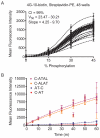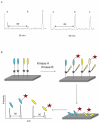Peptide reporters of kinase activity in whole cell lysates
- PMID: 20593469
- PMCID: PMC2914461
- DOI: 10.1002/bip.21401
Peptide reporters of kinase activity in whole cell lysates
Abstract
Kinase assays are used to screen for small-molecule inhibitors that may show promise as targeted pharmaceutical therapies. Using cell lysates instead of purified kinases provides a more accurate estimate of inhibitor sensitivity and selectivity in a biological setting. This review summarizes the range of homogeneous (solution-phase) and heterogeneous (solid-supported) formats available for using peptide substrates to monitor kinase activities in cell lysates. With a focus on heterogeneous kinase assays, the peptide substrate Abltide is used as a model to optimize presentation geometries and the modular arrangement of short sequences for kinase recognition. We present results from peptides immobilized on two- and three-dimensional surfaces such as hydrogels on 96-well plates and glass slides, and fluorescent Luminex beads. We discuss methods to increase assay sensitivity using chemifluorescent ELISAs, antibody-based recognition, and label-free mass spectrometry. Monitoring the activity of specific kinases in cell lysates presents challenges that can be overcome by manipulating peptide substrates to optimize assay conditions. In particular, signal-to-background ratios were improved by (1) adding long branched hydrophilic linkers between the substrate and the surface, (2) changing the orientation of peptides relative to the surface, and (3) including peptide ligands in cis or in trans to recruit kinases to the surface. By improving the accessibility of immobilized peptide substrates to kinases in solution, the apparent rate of phosphorylation increased and assays were more sensitive to changes in endogenous kinase activities. These strategies can be generalized to improve the reactivity of most peptide substrates used in heterogeneous kinase assays with cell lysates.
Copyright (c) 2010 Wiley Periodicals, Inc.
Figures







Similar articles
-
Photocleavable peptide-conjugated magnetic beads for protein kinase assays by MALDI-TOF MS.Bioconjug Chem. 2010 Oct 20;21(10):1917-24. doi: 10.1021/bc1003058. Bioconjug Chem. 2010. PMID: 20860375 Free PMC article.
-
Evaluation of protein kinase activities of cell lysates using peptide microarrays based on surface plasmon resonance imaging.Anal Biochem. 2008 Apr 15;375(2):223-31. doi: 10.1016/j.ab.2007.12.011. Epub 2007 Dec 15. Anal Biochem. 2008. PMID: 18191030
-
A multiplexed homogeneous fluorescence-based assay for protein kinase activity in cell lysates.Nat Methods. 2005 Apr;2(4):277-83. doi: 10.1038/nmeth747. Epub 2005 Mar 23. Nat Methods. 2005. PMID: 15782220
-
Biosensors of protein kinase action: from in vitro assays to living cells.Biochim Biophys Acta. 2004 Mar 11;1697(1-2):39-51. doi: 10.1016/j.bbapap.2003.11.012. Biochim Biophys Acta. 2004. PMID: 15023349 Review.
-
Enzyme Activity Assays for Protein Kinases: Strategies to Identify Active Substrates.Curr Drug Discov Technol. 2016;13(1):2-15. doi: 10.2174/1570163813666160115125930. Curr Drug Discov Technol. 2016. PMID: 26768716 Free PMC article. Review.
Cited by
-
Development of a peptidase-resistant substrate for single-cell measurement of protein kinase B activation.Anal Chem. 2012 Aug 21;84(16):7195-202. doi: 10.1021/ac301489d. Epub 2012 Aug 9. Anal Chem. 2012. PMID: 22881604 Free PMC article.
-
Major remodelling of the murine stem cell kinome following differentiation in the hematopoietic compartment.J Proteome Res. 2011 Aug 5;10(8):3542-50. doi: 10.1021/pr2001594. Epub 2011 Jun 28. J Proteome Res. 2011. PMID: 21648952 Free PMC article.
-
LIMS-Kinase provides sensitive and generalizable label-free in vitro measurement of kinase activity using mass spectrometry.Cell Rep Phys Sci. 2023 Oct 18;4(10):101599. doi: 10.1016/j.xcrp.2023.101599. Epub 2023 Sep 26. Cell Rep Phys Sci. 2023. PMID: 38213501 Free PMC article.
-
Metabolism of peptide reporters in cell lysates and single cells.Analyst. 2012 Jul 7;137(13):3028-38. doi: 10.1039/c2an16162a. Epub 2012 Feb 7. Analyst. 2012. PMID: 22314840 Free PMC article.
-
Photocleavable peptide-conjugated magnetic beads for protein kinase assays by MALDI-TOF MS.Bioconjug Chem. 2010 Oct 20;21(10):1917-24. doi: 10.1021/bc1003058. Bioconjug Chem. 2010. PMID: 20860375 Free PMC article.
References
-
- Manning G, Whyte DB, Martinez R, Hunter T, Sudarsanam S. The protein kinase complement of the human genome. Science. 2002;298(5600):1912–1934. - PubMed
-
- Gray N, Detivaud L, Doerig C, Meijer L. ATP-site directed inhibitors of cyclin-dependent kinases. Curr Med Chem. 1999;6(9):859–875. - PubMed
-
- Sawyers C. Targeted cancer therapy. Nature. 2004;432(7015):294–297. - PubMed
Publication types
MeSH terms
Substances
Grants and funding
LinkOut - more resources
Full Text Sources
Other Literature Sources

